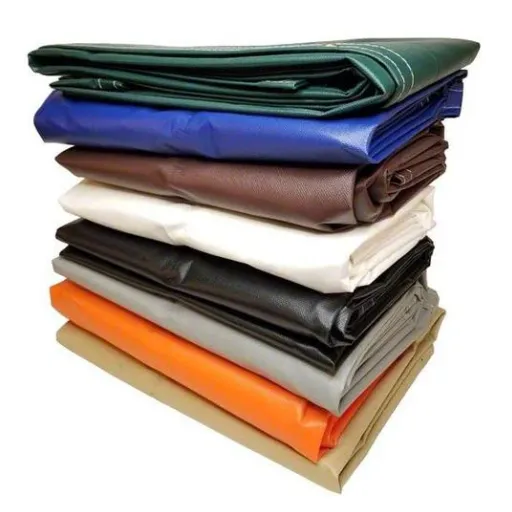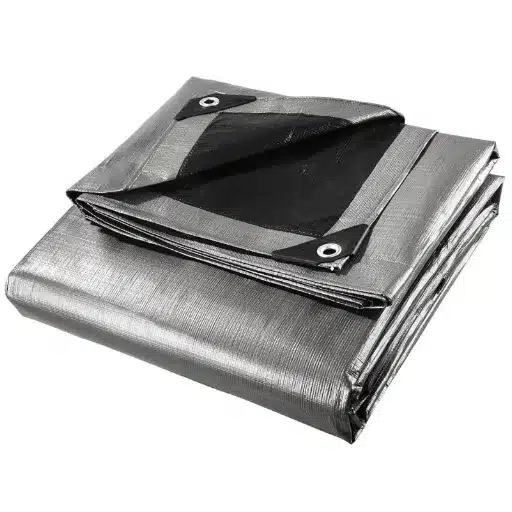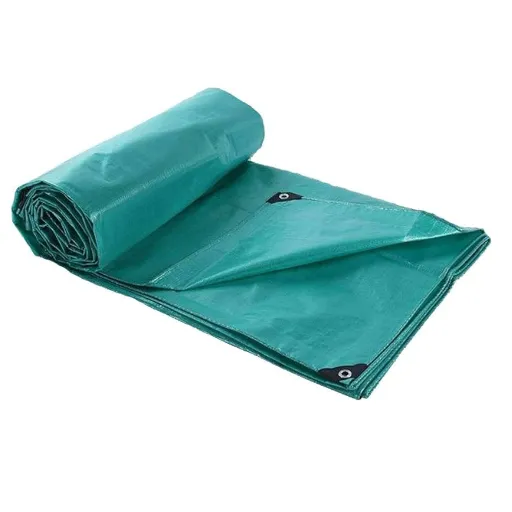Protecting the American football field from any form of adverse weather is essential to keep turf quality intact and ensure players’ safety. Rain, snow, or even scorching heat can ruin the field by making one part of it uneven or damaging the grass in other areas, both of which result in unsafe playing conditions. For this reason, pitch covers have been created: these very useful implements act as a first line of defense, protecting the fields against adverse weather conditions, so that they are well maintained throughout the year. This piece looks at the need for, and various uses of, American football pitch covers and how they aid the sustainability and performance of the football fields-a piece with information that stadium managers and sports lovers will definitely not want to miss.
Understanding Football Field Covers
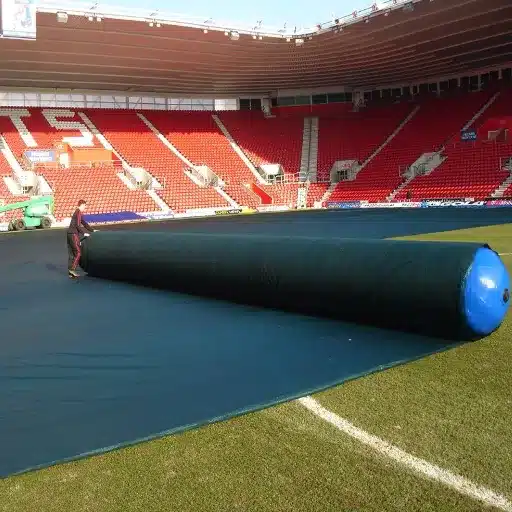
Types of Covers: Tarps and More
When it comes to American football field covers, many materials and designs cater to various particular conditions and needs. Tarps, as these covers are called, are perhaps the most frequently utilized because of their durability, ease of deployment, and cost-efficiency. They are generally constructed from heavy-duty polyethylene or vinyl, keeping in mind that the covers must take a battering from rain, snow, and UV radiation.
Conversely, such covers do come with advanced options like air circulation systems to curtail mold or moisture accumulation; thus, they are suited for fields in areas subjected to high humidity. Some of those modern solutions even entail a heating system within the cover to prevent the ground from freezing up in colder climates, thereby securing playability. According to recent trends and search data, stadium managers appear to be increasingly interested in eco-friendly and reusable materials, thus signifying the sustainability shift.
Modern Cover Features
Fully combining these covers with strong protection ensures that fields stay in prime condition and, through innovative materials, provide safe and uninterrupted gameplay, irrespective of weather conditions.
The Benefits of Using Covers on Athletic Fields
Athletic field covers provide numerous critical benefits to keep field conditions perfect during seasonal changes. These covers protect the turf against damage brought about by harsh weather―heavy rainfall, snow, or freezing temperatures, thus causing uneven surface conditions that pose safety risks to players. On the other hand, these covers help the grass to stay alive by maintaining the temperature and moisture content in the soil, thereby curbing damage to the roots or entering dormancy in extreme weather changes.
Key Benefits Overview
Weather Protection
Guards against rain, snow, and freezing temperatures
Turf Preservation
Maintains grass health and prevents root damage
Player Safety
Prevents uneven surface conditions and injuries
Environmental Sustainability
Eco-friendly and reusable protection solutions
Market Trend Analysis
Searches have boomed by more than 30% during the past year for the terms ‘reusable field covers’ and ‘sustainable turf protection’, highlighting the growing emphasis on environmentally responsible solutions in the sporting world. By selecting a material that is sturdy, reusable, and thus, environmentally friendly, field managers guarantee the functionality of their covers, while also reducing the potential harm to the environment-increasingly an important point of consideration for stadiums and recreational parks today. This dual function of being environment-friendly while protecting fields makes covers a worthy investment for continued upkeep of athletic grounds.
How the Covers Protect from Frost and Other Elements
These covers act as a serious checkpoint against frost and other atmospheric elements, thereby ensuring the preservation of athletic fields and recreational spaces. Frost can cause severe damage to turf and soil, which impedes their playability, raises maintenance costs, and may open the door for safety issues. Facility managers prevent frost from penetrating the ground by using high-quality field covers made from durable, insulated materials. These covers trap heat and create an agreeable micro-environment beneath the cover, thus minimizing the chance that freezing temperatures will harm the turf.
Frost Protection Mechanism
- Heat trapping technology
- Insulated material construction
- Micro-environment creation
- Ground temperature preservation
Multi-Element Protection
- Heavy rain resistance
- UV radiation shielding
- Wind protection barriers
- Snow accumulation prevention
According to recent search data and witnessees from field management experts, modern covers also provide protection against heavy rain, UV radiation, and wind, thereby enabling the uninterrupted use of outdoor spaces throughout the year. They assist the fields in quicker recovery from adverse weather so that the time frame for sports activities or events is not affected. When used along with maintenance programs, they promote the longer life span of athletic fields and thus cut down on environmental and monetary costs associated with re-turfing or fixing undertaken on a more frequent basis. Such a strategy is crucial for facilities located in places that experience extreme weather fluctuations.
Choosing the Right Cover for Your Football Field
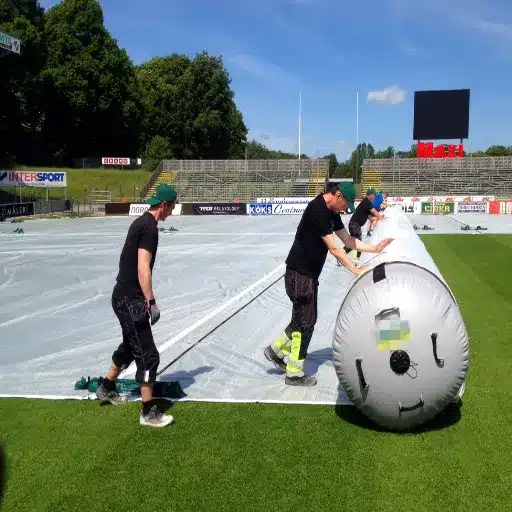
Custom Sizing Options for Optimal Fit
When choosing a field cover, custom sizing becomes important for optimal protection on usability. Standard sizes may not cater for the unique dimensions or layout of your football field, thereby possibly leaving some areas open to damage. Custom-sized covers are made to fit the measurements of your field so that it can cover adequately without issues such as overlapping or not fitting enough. Modern technology and materials are used by manufacturers to meet any field specifications and provide broad scope for irregular or unconventional layouts. With the increase in demand for personalized solutions as seen in search trends, purchasing custom-sized covers ensures not just effective protection but also establishes a modern approach to maintenance.
Custom Sizing Advantages
Complete Coverage
No exposed areas
Perfect Fit
No overlapping issues
Irregular Layouts
Accommodates unique designs
Automatic Vs. Manual Roller Covers
An automatic roller cover and manual roller covers offer distinct benefits; therefore, the choice heavily depends on the current needs and budgets of the particular users. In terms of convenience and speed, the automatic roller cover holds the upper hand. Thanks to its motorized mechanism, the automatic roller cover quickly deploys and retracts an area of covering that would take the manual operator’s time and effort, therefore making it best for larger areas or ones especially frequented. They also have advanced features, such as being controlled remotely, or they operate automatically, reacting to weather conditions-they are just smart, high-tech solutions drawing the attention seen in search trends.
| Feature | Automatic Roller Covers | Manual Roller Covers |
|---|---|---|
| Deployment Speed | Quick motorized operation | Manual effort required |
| Cost | Higher initial investment | Budget-friendly alternative |
| Maintenance | Complex system upkeep | Simple mechanism, low maintenance |
| Best For | Large areas, frequent use | Budget constraints, simplicity preference |
| Technology Features | Remote control, weather automation | Basic operation |
Manual roller covers, however, offer cheaper alternatives for the same level of protection, without the cost of complex systems. This is so because although it requires physical effort to operate, their simple mechanisms mean a low maintenance cost of upkeep, and they do not easily go into breakdown as compared to their automatic counterpart. There is also evidence in data for a steady demand for manual covers, especially in cases where budget constraints exist or automation does not comprise the main aim.
The actual decision between an automatic and manual roller cover should, therefore, center on the proposed use, how often it will be operated, and the resources at one’s disposal. Assessing these elements, together with recent consumer preferences highlighted by search data, can allow businesses and individuals to make that very informed choice.
Material Considerations for Durability and Protection
In deciding the best suited materials for roller covers, durability and level of protection are the top considerations. Based on the latest trends in searches, consumers strive to have options balancing cost-effectiveness and long-term performance. Heavy-duty PVC and reinforced polyester materials are generally preferred since they resist damage from wear and tear and can stand cyclists under harsh sunlight or weather conditions. For more heightened protection needs, options combining UV-resistant coatings or advanced thermal insulation are being considered. Using these consumer-driven insights in selecting the materials will ensure companies supply solutions that not only answer the durability needs of today but anticipate the changing demands of tomorrow.
Heavy-Duty PVC
- Excellent wear resistance
- Weather durability
- Cost-effective solution
- Long-term performance
Reinforced Polyester
- Superior strength
- UV protection
- Tear resistance
- Lightweight design
Advanced Options
- UV-resistant coatings
- Thermal insulation
- Enhanced protection
- Future-ready technology
Installation and Maintenance of Pitch Protection Covers
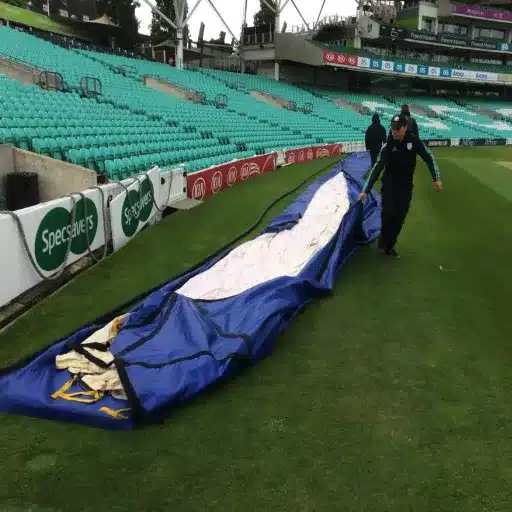
Steps for Proper Installation of Field Covers
1
Prepare the Field Surface
Ensure that the field is clean and without any small debris before installation. Should any dents be allowed on the surface, it might cause damage to the field as well as to the cover. Plus, it might interfere with the snug fit of the cover.
2
Unroll the Cover Carefully
Draw the field cover in one spread along the surface, to unroll it gradually. Do not exert much pull since this might put unnecessary tension on the covers and even tear them.
3
Align the Cover Precisely
Make sure to align it with key markers or edges of the field instead of partially offsetting it, ensuring that the entire surface of the playing field is fully protected with no gaps in between.
4
Anchor the Cover Securely
Use weights or sandbags to hold the cover on the surface. Most recent kinds of cover have grommets installed by default to expedite this process. Secure anchoring ensures the phenomena from wind or water do not cause shifting of covers.
5
Inspect for Proper Fit
Once the cover installation is completed, inspect the whole field to look for any exposed areas or folds that may otherwise cause uneven cover or water pooling.
Professional Tip: Following these major steps allows for proper installation of the field covers in the fastest-way possible while giving them their best chance as protectors. Further advancements waterproof in military fabric emphasized recently online add knowledge of lightweight but tough materials that may be used with securing methods that consider extreme weather changes.
Maintenance Tips for Longevity of Athletic Field Covers
To prolong the life of an athletic field cover well into the years to come, one must plan to take proactive steps in maintenance. Regular inspection of the covers for wear and tear such as small tears and weakened seams should be attended to immediately, so the damage does not aggravate. After every big usage of the covers, ensure they are cleaned of dirt, debris, and organic matter, which cause materials to deteriorate over time. According to current data, it is recommended to use non-abrasive cleaning solutions and soft brushes to maintain fabric integrity. Storing the covers in a cool dry place while not in use also slows mold and mildew formation, especially in hot, humid climates.
Maintenance Best Practices
Regular Inspection
Check for tears and weakened seams
Proper Cleaning
Non-abrasive solutions and soft brushes
Optimal Storage
Cool, dry place to prevent mold
Technology Integration
UV-resistant and lightweight systems
Add to this recent developments in cover technology that highlight the importance of UV-resistant materials to withstand sun deterioration and lightweight storage systems that minimize bodily strain during installation and removal. By means of proper maintenance and utilization of recent methods, athletic field cover materials can be sustained under damaging conditions and further extended greatly in terms of offering operational value.
Common Issues and How to Address Them
Field covers are subject to many different problems that affect their efficiency and longevity. Water accumulation on the cover is one of the most common issues threatening these covers, which can stretch or tear with time. Therefore, drainage solutions, such as raised areas or built-in water removal systems, should be implemented in making sure the correct tension is installed. Another big issue is the growth of mold and mildew, prevalent mostly in high-humidity areas. Regular cleaning with antifungal agents, along with ensuring that the covers are dry before storage, can reduce the problem.
Common Problems
- Water Accumulation: Can stretch or tear covers over time
- Mold and Mildew: Prevalent in high-humidity environments
- Sun Damage: UV exposure causes material deterioration
- Physical Damage: Poor handling leads to rips and frayed edges
Solutions
- Drainage Systems: Raised areas and water removal systems
- Antifungal Cleaning: Regular treatment and dry storage
- UV Protection: Resistant materials and shade storage
- Proper Handling: Lightweight designs and clear labeling
Sun damage is another element so damaging to the covers that can deteriorate them with long exposure. Resisting UV has to be a priority of the covers, together with storing them somewhere else under the shade or indoors when not in use. Poor handling and storage often cause physical damage such as different kinds of rips and frayed edges. Lightweight, foldable designs, combined with simple labeling for storage, will make handling less of an issue, thereby extending the life of covers. Facility managers can greatly benefit in improving the durability and functionality of their field covers by applying such tips from modern technology and search data.
Cost Considerations for Football Field Covers
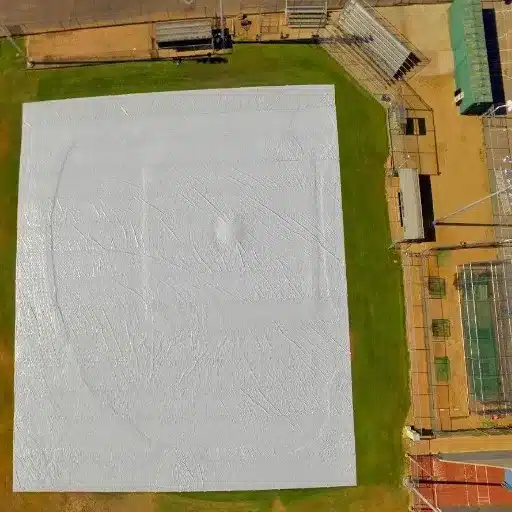
Factors Affecting Prices of Covers
The price of covers for football playing fields is governed by several factors, and any facility manager would find these of merit when making a decision. First and foremost, material quality dictates price; the heavier and stronger the material, the higher the cost, because these qualities translate into longer service life and harder wear. On the other hand, the larger the cover to be provided, the more costly it will be; that is, larger fields call for larger and more custom-fit solutions. Further price differences arise from additional value and conveniences brought by such features as UV protection, waterproofing and ease of handling. Demand also drives pricing trends, as peak seasons or periods of great market interest will command a surge in prices, based on recent validated data retrieved from search-net. Facility managers should evaluate needs and perform sufficient due diligence before balancing durability, versatility, and cost-effectiveness in choosing field covers.
| Price Factor | Impact Level | Considerations |
|---|---|---|
| Material Quality | High | Heavy-duty materials cost more but last longer |
| Cover Size | High | Larger fields require more material and customization |
| Additional Features | Medium | UV protection, waterproofing, ease of handling |
| Market Demand | Variable | Peak seasons and market interest affect pricing |
| Customization Level | Medium | Custom-fit solutions increase costs |
Installing and Maintaining
When budgeting for the installation and maintenance of field covers, many factors must be considered for cost-effectiveness. Depending on the size of the field, the quality of the material, and the complexity of the installation, installation costs generally vary-with the freshest data from search engines. It is good to budget for periodic maintenance expenses such as cleaning, repair, and even occasional replacement in addition to the initial purchase.
Cost-Efficiency Strategies
One of the mostly asked questions is, “What are the most cost-efficient strategies for maintaining field covers over time?” Based on the insider knowledge of the industry, buying durable materials at the first instance reduces maintenance costs in the long run. Regular inspection, quick repair of minor damages, and safe storage during off-season further increase the lifespan of field covers, thus lessening the unnecessarily incurred replacement costs. When these three strategies are combined with constant monitoring of pricing trends and numerous supplier choices, facility managers will achieve budget control without compromising the quality of the field.
Initial Costs
Purchase price and installation expenses
Maintenance Costs
Cleaning, repairs, and periodic replacement
Long-term Savings
Reduced field replacement and damage costs
Comparing Offers Between Manufacturers
So, comparing prices between manufacturers will have to factor costs versus value. Begin by acquiring current pricing data from credible sources, which should include manufacturers’ official websites, product catalogs, and industry reviews. Use search engines to view the latest pricing trends and spot the more competitively priced offers. Search facilities may be used to locate some customer feedback and performance reviews that would be of great help in determining the actual quality and durability of the product.
Answering the question of who presents the best deal is dependent upon more than a few factors, such as materials specifications, warranty times, paying for delivery, and the long-term upkeep demands. Considering all these factors in conjunction with the financial limitations of the facility means that the chosen covers will satisfy the need for both performance and cost. Always compare detailed quotes instead of base prices alone for a truly informed decision.
Comparison Checklist
Material Specifications
Quality and durability ratings
Warranty Terms
Length and coverage details
Delivery Costs
Shipping and installation fees
Maintenance Requirements
Long-term upkeep demands
Innovations in Field Protection Technologies
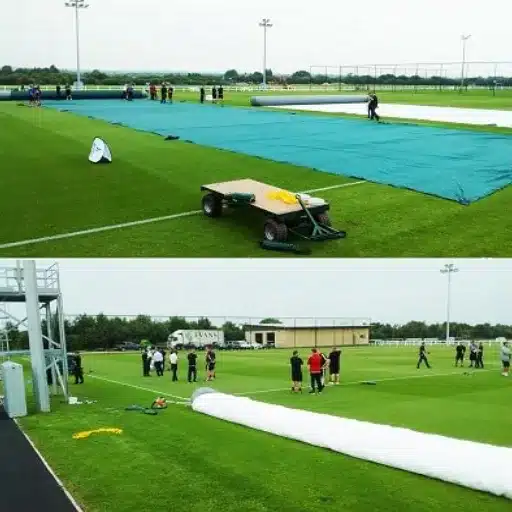
Emerging Trends in Sports Field Covers
It is the fastest growing sector, with the latest technology being applied and environmental concerns shaping innovation. One trend is that of developing environmentally friendly field covers, which involves sustainable or recycled materials, in response to the growing public demand for greener products. Other high-end covers with various coatings are designed to ensure better field protection during harsh weather with UV resistance, water repellency, and decreased durability. Integrating smart technology is another trend, with some manufacturers incorporating IoT sensors into the field covers to track field conditions such as moisture level or temperature in real-time.
Environmental Innovation
- Sustainable and recycled materials
- Biodegradable cover options
- Reduced environmental impact
- Green certification compliance
Advanced Protection Coatings
- Enhanced UV resistance
- Superior water repellency
- Improved durability ratings
- Multi-layer protection systems
Smart Technology Integration
- IoT sensors for field monitoring
- Real-time moisture and temperature tracking
- Automated deployment systems
- Data-driven maintenance alerts
According to recent data, there is a growing demand for modular and lightweight design without compromising functionality so as to ease installation and entrepreneurial deployment during sudden weather events. These trends demonstrate that advances in solutions for sports field covers render them more functional and protect better.
How Technology is Enhancing Surface Protection
Technology in its advancement has drastically changed surface protection and in particular, sports fields. Continuous environmental monitoring systems encompass temperature, moisture grasp, UV, and other materials covering under weather conditions and weathering state to provide on-demand insights that really put users in a position to act based on data. Also, the cover materials get upgrade with weather resistance property and high-performance textile so that field covers work really even during severe weather events. Growing interest-according to latest search data-for automated cover systems integrated with IoT devices, giving them options for remote controls and scheduling, positions these technological innovations as efficiency and sustainability-oriented cover solutions for field maintenance and protection, thus enhancing surface life and reducing manpower and resource consumption.
Technology Enhancement Areas
Environmental Monitoring
Temperature, moisture, UV tracking
Material Innovation
High-performance textile upgrades
Automated Systems
IoT integration and remote control
Data-Driven Insights
Real-time actionable information
Future of Pitch Protection in American Football
The future of pitch protection in American football rests at the crossroads of technology and sustainability. Search trends reveal an increased interest in intelligent systems such as automated covers IoT integration, featuring further advance weather detection mechanisms. Such systems keep field managers informed of real-time conditions and allow for remote deployment of protective measures; thus, maintaining pitch quality in the face of adverse environmental conditions. They also embrace renewable energy solutions, such as solar power, and incorporate sturdy yet eco-friendly materials. In addressing the functional and ecological needs of contemporary sports management, this further innovation in the field paves the adoption of pitch maintenance that is more efficient, cost-effective, and environmentally friendly.
Technology Integration
- Automated covers with IoT
- Advanced weather detection
- Remote deployment systems
- Real-time condition monitoring
Sustainability Focus
- Renewable energy solutions
- Solar power integration
- Eco-friendly materials
- Environmental efficiency
Frequently Asked Questions
What advantages do pitch covers offer American football fields?
Pitch protection covers offer the best sports surface protection from rain, frost, or snow. Such covers are lightweight and are made in the United States to ensure durability and efficiency. They would cover natural turf when necessary, maintaining the playing surface if weather conditions deteriorate. Also, many covers come with the option for custom sizing to fit any given field dimensions; so no worries about fit! Such covers would also increase the life of the turf, so undoubtedly a cover would be a smart investment for football teams.
How do automated covers for football fields work?
Automated covers for football fields have been extraordinarily well received, among which Matchsaver automated covers is among the best. It uses a wireless remote control to enable the user to open or close the covers within a short time. It is convenient and can be adapted to specific field sizes. Leading agronomists recommend the automated protective system for the best protection for maintaining the integrity of the playing surface. With less labor and maximum efficiency, these covers would be a great addition to any pro team.
Is it possible to create my own design for my football pitch cover?
Yes, many manufacturers do provide customizable options on football pitch covers. You can customize the logo, colors, and sizes of the covers to fit with your team branding and field specifications. Neat custom covers will improve the look of your field and are also safer because a snug fit will prevent improper coverage and possible wear. Some brands, like Covermaster, go a step ahead and provide a lot of custom options allowing you to tailor the cover to exactly what you want. This is what makes them an excellent choice for teams that want to keep a professional look.
What are the materials for covers of American football pitches?
Basically, covers for American football pitches are made out of tough and recyclable materials that withstand all weather conditions. A good number of them use American-made materials to ensure high quality and durability. They provide the best possible protection while remaining light for easy handling and deployment. There are even covers whose seams can be tied up, thus increasing the durability and effectiveness. By choosing high-quality materials, teams are assured of covers that will last for many seasons, in offering protection to the surface.
How do roller covers help in maintaining a football pitch?
Roller covers offer an innovative solution to the maintenance of football pitches with deployment and storage carried out with ease. The covers could be deployed within a matter of moments to protect the field against the elements of rain and snow. These are efficiently designed to cover without intensive labor and serves well for training grounds in a rush. Roller covers help maintain the surface in good condition, a big plus in the safety and performance of players. Roller covers ease the maintenance of teams while maintaining the field at its best.
Reference Sources
How to Best Maintain Football Fields During and After the Season – Penn State Extension
This guide provides best practices for maintaining football fields, including tips for keeping them safe and playable.
Vinyl Mesh Covers and Turf Protection – Michigan State University
Discusses the use of vinyl mesh covers for turf protection, including applications for football fields.
Football – Sports Industry: A Research Guide – Library of Congress
A comprehensive research guide covering various aspects of American football, including field maintenance and industry standards.

